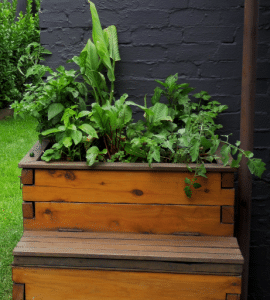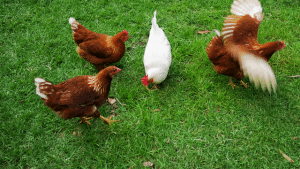You may have an aquaponics system full of plate size fish? In other words, ready for harvest? As a result, you wonder how long you will be able to keep the aquaponics system without fish for…
In this article I would like to share my experience with fishless aquaponics. As you may know, I recently moved to a new house. One of the aquaponics had trouts. As I moved to the new house, I moved the aquaponics system but kept it without fish for a month. The plants are growing very well and don’t show any sign of deficiency. So how to explain this?
Even without fish, the aquaponics grow-bed provides nutrients.

aquaponics system without fish
The main aquaponis system input is the fish food. Therefore, it would be logical to conclude that without fish, we don’t have plants fertilizer any longer. However, in practice we can remove the fish from an established aquaponics system and see the plants continuing to grow for months. So what is happening there? Let me explain. In a flood and drain aquaponics grow-bed, we have a large volume of media. Also, the media is loading in organic matters. That is to say fish waste, plants roots, plants leaves, old bacteria… Therefore, there is a “reserve” of organic matters in your grow-bed. Depending on the organic matters load, it may take months for the ecosystem to digest this “food”. Hence, even without fish in your aquaponics system, your plants will be able to continue growing.
2 advantages of this “nutrients reserve”
Keeping temperature sensitive fish
You may live in a region of the world where the temperature are significantly fluctuating. In this case, it may be difficult to offer good growing conditions for the fish you aim to grow all year long. In Melbourne Australia for instance, we have large climate variation between seasons. It can be relatively cold in winter (as low as minus 2C) and warm in summer (over 40C). In those conditions, it is difficult to find fish able to grow all year round. One of the solutions is to select a fast-growing fish such as trout. And to grow it for only 9 months in the year. Indeed, trouts will reach plate size in this short period. In this case we can harvest our fish. Then, we will keep the aquaponics system without fish for the 3 remaining months. This technique can be applied with different species as long as: They are fast growing and adapted to the water temperature for at least 9 months of the year.
Decreasing the maintenance needs
The second advantage is regarding the aquaponics system maintenance. Indeed, if you follow my articles, you know that the grow-bed must be cleaned every few years. By leaving the system “purge” without fish for few months, you will decrease the need for grow-bed clean up. The action to clean the grow-bed is the most demanding aquaponics maintenance task. By decreasing this maintenance demand, you are doing yourself a big favor. This is even more true if you have a large flood and drain aquaponics system.
How long can we keep the system without fish?
The quantity of organic matters present in your grow-bed will determine how long you can keep your aquaponics system without fish. Of course, the quantity of plants growing on the media will also have an impact. Anyway, you may be able to last for 2 months or more without adding fish in the system. But after this period, you will see some deficiencies on your plants. In other words, the leaves will turn yellow. Different types of deficiencies can occur. We mainly see 2 types that are mineral deficiencies and nitrogen deficiencies. For the minerals, we will simply add some rock powder or a mix of trace elements. Regarding the nitrogen deficiencies, we have different options…
Keeping the system running
With fish
The easiest thing to do is to add some fish back into the system. This solution is ideal. However, the season may be inappropriate for the type of fish you would like to introduce. In this case we need to use one of the two techniques below
Fertilizer
You can add plant fertilizer to the system. It is mainly composed of nitrate plus phosphorus and potassium (NPK). This is ideal for keeping the plants growing but I see here some disadvantages. You see where I am going? Well, first, the plant fertilizer is generally not sustainable and has a cost. Secondly, When you add nitrate directly into the system. Your bacteria don’t find any food there. In those specific conditions, we are very close to an hydroponics culture. So you have an army of bacteria that will slowly die. Don’t be afraid, they will not completely disappear. As soon as you add new fish, they will quickly grow back. But I think it’s a shame to not use those creatures ready to work for you.
Animal waste

Chicken producing manure
One option is to substitute the original fish waste with another animal waste easily available. We can think of chicken waste, cheep, goat, cow… If you choose this path, there are few things you must know. First it is difficult to know the quantity to add into the system so be very careful and work with very small quantities.
Last but not least, there is one safety point that I must emphasize here. When we work in aquaponics, we are working with fish. Fish are cold blood animals. There are no bacteria or disease transmissible from fish to human. That is the reason why aquaponics is fundamentally safe. It allows us to consume the plants directly without cooking step. When you work with other types of warm blood animals, this is a totally different story. Worm blood animals can carry pathogen bacteria (Listeria mono, E coli) in their waste. Those can be transmissible to human and be very dangerous. That is the reason why, if you chose this option, you must: Meticulously wash your crop and cook it before consumption.
From my perspective, it misses the purpose of aquaponics which is to produce healthy food. By cooking the food, we reduce the vitamins and nutrients available. Anyway, this technique is not aquaponics any longer as it doesn’t involve the aquatic creature (fish). In conclusion I would say that keeping your aquaponics system without fish is not a problem. Rather, it can be beneficial to the whole ecosystem. However, restocking your system with fish after this period is the way to go.
You will probably be interested to discover my six steps to build and manage an Aquaponics system. Click here to access for free! Thanks and good reading 🙂

